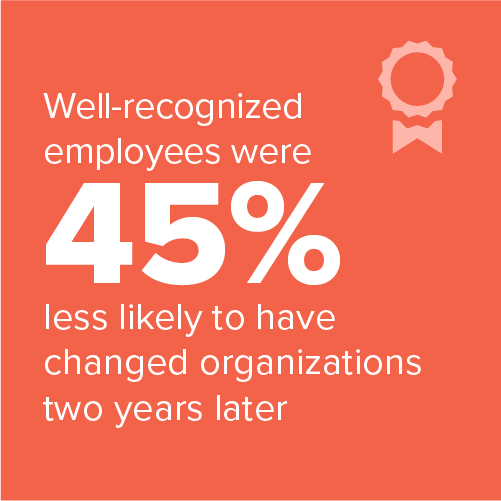

There are few better feelings than the recognition that finds you when you know you’ve done great work on a project, have broken a company record, or hit a new milestone. It motivates you to keep up a strong performance and makes you feel valued as an important part of the company.
But how many times do you think that great work has gone unnoticed or unmentioned? It's happened to all of us at some point in our careers. We all know it doesn’t feel good and that’s why having structured employee recognition programs in place is crucial to keeping morale high and turnover low.
The numbers don’t lie. Research from Gallup has shown that, “well-recognized employees are 45% less likely to have turned over after two years, making recognition one of the most cost-effective retention strategies available.”
If you’re looking for new ways to recognize all the hard work getting done at your workplace, this guide will take you through 10 proven employee recognition programs of all types.
Let’s get started…
The definition is in the name - but employee recognition programs are systematic approaches to acknowledging and rewarding the people that work for your organization. They tend to fall into three main categories: monetary, social, and peer-to-peer.
The most effective strategies combine all three types based on the situation and employee preferences so a hybrid approach is usually best. So combine a few of your favorite options from the list below.
We’ll go in order of program type and then discuss the best ways to blend them all for the perfect employee recognition program.

Using spontaneous bonuses or gift cards is a great way to create a competitive but friendly and encouraging environment. When you can walk into the office on a slow Friday morning and say, “whoever the top three sellers are today get a $100 gift card of their choosing,” it gets things rolling. It’s a great motivational tool and way to recognize your top performers for the day.
Recognizing employees by matching their charitable contributions. The new generation of workers care a lot about their employers having purpose outside of their main business functions.
This is a great way to show them your business cares about the causes they do while doubling the impact of their giving. It also positions the company as one that wants to improve the community they operate in.
Having a way employees can grow both professionally and financially is the ultimate monetary recognition. Permanent compensation increases or role advancement based on sustained high performance and leadership potential will keep them motivated to always bring their best to your organization.

People love to share their accomplishments on social media and keep their friends and families updated on their lives. By featuring employee accomplishments on the company LinkedIn, Instagram, or other channels, you can help employees build their personal brand and get additional recognition from people outside your company.
It’s important to honor tenure milestones (1, 5, 10+ years) with public recognition. Something like a celebration with food from their favorite local restaurant and extra PTO day. Long-term employees provide stability and institutional knowledge that is important for company growth and equally as important to recognize properly.
One of the most widely known employee recognition programs and for a good reason, it works! It can be challenging to bring your absolute best every day and those that constantly do deserve additional recognition. Be specific when calling out an employee's achievements and send the message far and wide.

Create a dedicated channel in Slack or Microsoft Teams where anyone can post an appreciation or shout out message to the company. This has a very low-barrier to entry and makes all wins no matter how big or small appreciated.
Have a system where people can submit a peer nomination to call out an instance of someone going above and beyond what was required of them. It can then get read out at the company all hands meeting, which gives the person the recognition they deserve in a very public way. It’s a great way to make sure nothing goes unnoticed and creates a positive workplace environment.
Providing subsidized or free meals during lunch via Popups, delivery, cafeteria, or pantry programs is an ongoing way to recognize employee value. This greatly improves the daily workplace experience by bringing people together, putting money back in your employees’ pockets, and saving them time and energy over what they’re going to eat.
Recognize significant project completions, sales goals, or product launches with team celebrations, lunches, or a special event with catering from their favorite local restaurant. These moments mark important wins while bringing teams together to acknowledge collective success.
Now that you’ve got 10 great ideas to improve your employee recognition program, you need to think about how you’d like to implement them.
It starts by defining what you’d like to accomplish and ways to measure the impact of the system you design. You might be looking to improve recruiting and retention, office engagement, or might just want to improve morale.
Once you understand the approach (and budget) you can then gather employee input on what they think would be most effective. Some people might prefer public recognition while others would prefer it stay private. Understanding preferences will make sure you design a program that's inclusive for everyone on the team.
After that, create a simple and accessible process that makes recognition easy to give and receive. If it’s not straight forward, participation will be low and your efforts could be wasted. One of the best ways to keep participation high is by keeping those in leadership positions involved in the process. It will mean a lot when the people at the top put emphasis on consistently strong performances.
From there, you can adapt and grow your employee recognition program as you see fit. Some of the ideas might not be a perfect match for your office and can be changed to meet the needs of your company as it grows.
But remember to avoid these five common mistakes when building your program:
Whether you implement all 10 programs or focus on five that fit your organization, combining monetary rewards, social recognition, and peer appreciation creates an environment where employees feel genuinely valued.
The most successful recognition programs share these common traits: they're frequent, specific, personalized, and accessible to all employees. Yet formal recognition programs represent only part of the equation. The highest-performing organizations understand that daily workplace experiences matter just as much as structured awards.
Time and time again, research shows that corporate dining programs rank as one of the most valued perks by employees. These programs work because they address a fundamental daily need while creating natural touchpoints for recognition, collaboration, and culture building.
Ready to strengthen recognition through daily workplace experiences? Discover how Fooda's workplace food programs create consistent moments of appreciation around the lunch table.
Absolutely. Remote recognition requires intentional systems but can be equally effective as in-person programs. The key is making recognition frequent, visible, and accessible regardless of location, ensuring remote employees receive the same appreciation as on-site workers.
Lack of recognition makes employees feel invisible and undervalued, leading to disengagement and eventual departure. When hard work goes unnoticed, employees question whether their contributions matter, reducing motivation and commitment.